Yuxin Huang
Multilingual Generative Retrieval via Cross-lingual Semantic Compression
Oct 09, 2025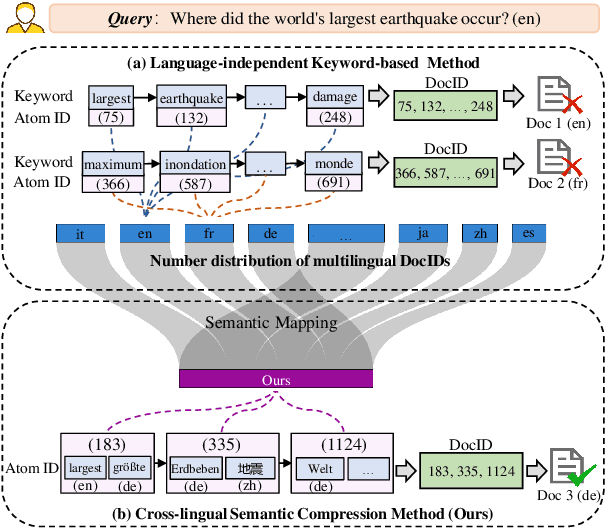
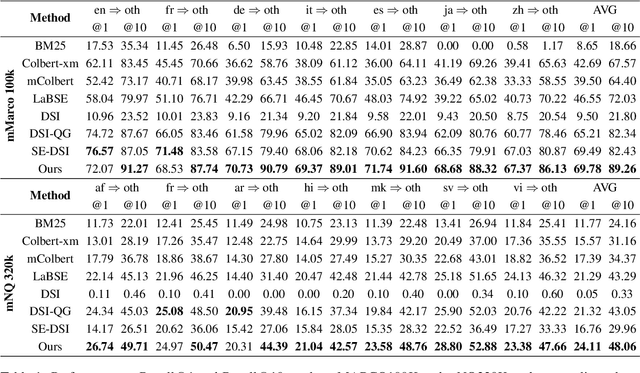
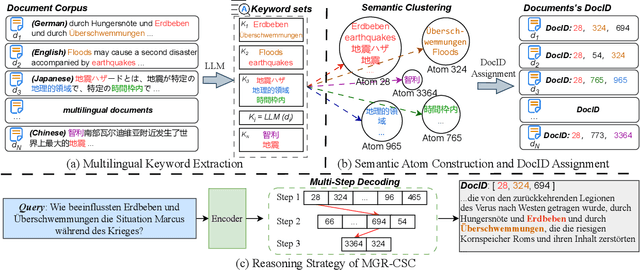

Abstract:Generative Information Retrieval is an emerging retrieval paradigm that exhibits remarkable performance in monolingual scenarios.However, applying these methods to multilingual retrieval still encounters two primary challenges, cross-lingual identifier misalignment and identifier inflation. To address these limitations, we propose Multilingual Generative Retrieval via Cross-lingual Semantic Compression (MGR-CSC), a novel framework that unifies semantically equivalent multilingual keywords into shared atoms to align semantics and compresses the identifier space, and we propose a dynamic multi-step constrained decoding strategy during retrieval. MGR-CSC improves cross-lingual alignment by assigning consistent identifiers and enhances decoding efficiency by reducing redundancy. Experiments demonstrate that MGR-CSC achieves outstanding retrieval accuracy, improving by 6.83% on mMarco100k and 4.77% on mNQ320k, while reducing document identifiers length by 74.51% and 78.2%, respectively.
SageLM: A Multi-aspect and Explainable Large Language Model for Speech Judgement
Aug 28, 2025Abstract:Speech-to-Speech (S2S) Large Language Models (LLMs) are foundational to natural human-computer interaction, enabling end-to-end spoken dialogue systems. However, evaluating these models remains a fundamental challenge. We propose \texttt{SageLM}, an end-to-end, multi-aspect, and explainable speech LLM for comprehensive S2S LLMs evaluation. First, unlike cascaded approaches that disregard acoustic features, SageLM jointly assesses both semantic and acoustic dimensions. Second, it leverages rationale-based supervision to enhance explainability and guide model learning, achieving superior alignment with evaluation outcomes compared to rule-based reinforcement learning methods. Third, we introduce \textit{SpeechFeedback}, a synthetic preference dataset, and employ a two-stage training paradigm to mitigate the scarcity of speech preference data. Trained on both semantic and acoustic dimensions, SageLM achieves an 82.79\% agreement rate with human evaluators, outperforming cascaded and SLM-based baselines by at least 7.42\% and 26.20\%, respectively.
ReconVLA: Reconstructive Vision-Language-Action Model as Effective Robot Perceiver
Aug 14, 2025Abstract:Recent advances in Vision-Language-Action (VLA) models have enabled robotic agents to integrate multimodal understanding with action execution. However, our empirical analysis reveals that current VLAs struggle to allocate visual attention to target regions. Instead, visual attention is always dispersed. To guide the visual attention grounding on the correct target, we propose ReconVLA, a reconstructive VLA model with an implicit grounding paradigm. Conditioned on the model's visual outputs, a diffusion transformer aims to reconstruct the gaze region of the image, which corresponds to the target manipulated objects. This process prompts the VLA model to learn fine-grained representations and accurately allocate visual attention, thus effectively leveraging task-specific visual information and conducting precise manipulation. Moreover, we curate a large-scale pretraining dataset comprising over 100k trajectories and 2 million data samples from open-source robotic datasets, further boosting the model's generalization in visual reconstruction. Extensive experiments in simulation and the real world demonstrate the superiority of our implicit grounding method, showcasing its capabilities of precise manipulation and generalization. Our project page is https://zionchow.github.io/ReconVLA/.
CEED-VLA: Consistency Vision-Language-Action Model with Early-Exit Decoding
Jun 16, 2025
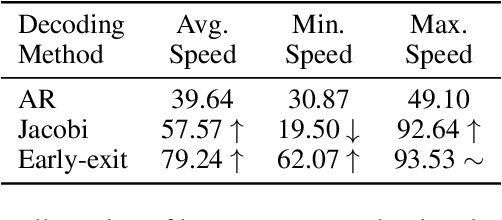
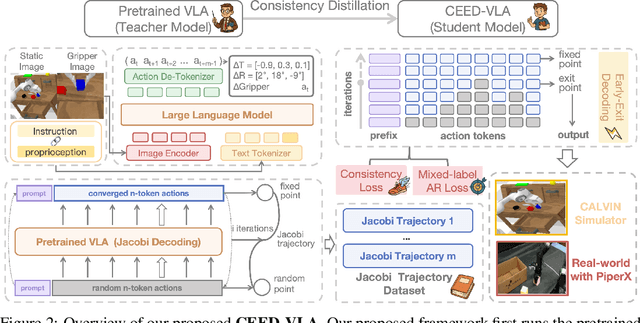
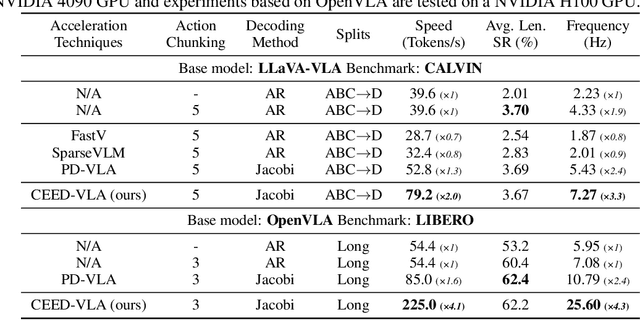
Abstract:In recent years, Vision-Language-Action (VLA) models have become a vital research direction in robotics due to their impressive multimodal understanding and generalization capabilities. Despite the progress, their practical deployment is severely constrained by inference speed bottlenecks, particularly in high-frequency and dexterous manipulation tasks. While recent studies have explored Jacobi decoding as a more efficient alternative to traditional autoregressive decoding, its practical benefits are marginal due to the lengthy iterations. To address it, we introduce consistency distillation training to predict multiple correct action tokens in each iteration, thereby achieving acceleration. Besides, we design mixed-label supervision to mitigate the error accumulation during distillation. Although distillation brings acceptable speedup, we identify that certain inefficient iterations remain a critical bottleneck. To tackle this, we propose an early-exit decoding strategy that moderately relaxes convergence conditions, which further improves average inference efficiency. Experimental results show that the proposed method achieves more than 4 times inference acceleration across different baselines while maintaining high task success rates in both simulated and real-world robot tasks. These experiments validate that our approach provides an efficient and general paradigm for accelerating multimodal decision-making in robotics. Our project page is available at https://irpn-eai.github.io/CEED-VLA/.
Leveraging Unit Language Guidance to Advance Speech Modeling in Textless Speech-to-Speech Translation
May 21, 2025



Abstract:The success of building textless speech-to-speech translation (S2ST) models has attracted much attention. However, S2ST still faces two main challenges: 1) extracting linguistic features for various speech signals, called cross-modal (CM), and 2) learning alignment of difference languages in long sequences, called cross-lingual (CL). We propose the unit language to overcome the two modeling challenges. The unit language can be considered a text-like representation format, constructed using $n$-gram language modeling. We implement multi-task learning to utilize the unit language in guiding the speech modeling process. Our initial results reveal a conflict when applying source and target unit languages simultaneously. We propose task prompt modeling to mitigate this conflict. We conduct experiments on four languages of the Voxpupil dataset. Our method demonstrates significant improvements over a strong baseline and achieves performance comparable to models trained with text.
A Mixed-Language Multi-Document News Summarization Dataset and a Graphs-Based Extract-Generate Model
Oct 13, 2024Abstract:Existing research on news summarization primarily focuses on single-language single-document (SLSD), single-language multi-document (SLMD) or cross-language single-document (CLSD). However, in real-world scenarios, news about a international event often involves multiple documents in different languages, i.e., mixed-language multi-document (MLMD). Therefore, summarizing MLMD news is of great significance. However, the lack of datasets for MLMD news summarization has constrained the development of research in this area. To fill this gap, we construct a mixed-language multi-document news summarization dataset (MLMD-news), which contains four different languages and 10,992 source document cluster and target summary pairs. Additionally, we propose a graph-based extract-generate model and benchmark various methods on the MLMD-news dataset and publicly release our dataset and code\footnote[1]{https://github.com/Southnf9/MLMD-news}, aiming to advance research in summarization within MLMD scenarios.
Attention Heads of Large Language Models: A Survey
Sep 05, 2024



Abstract:Since the advent of ChatGPT, Large Language Models (LLMs) have excelled in various tasks but remain largely as black-box systems. Consequently, their development relies heavily on data-driven approaches, limiting performance enhancement through changes in internal architecture and reasoning pathways. As a result, many researchers have begun exploring the potential internal mechanisms of LLMs, aiming to identify the essence of their reasoning bottlenecks, with most studies focusing on attention heads. Our survey aims to shed light on the internal reasoning processes of LLMs by concentrating on the interpretability and underlying mechanisms of attention heads. We first distill the human thought process into a four-stage framework: Knowledge Recalling, In-Context Identification, Latent Reasoning, and Expression Preparation. Using this framework, we systematically review existing research to identify and categorize the functions of specific attention heads. Furthermore, we summarize the experimental methodologies used to discover these special heads, dividing them into two categories: Modeling-Free methods and Modeling-Required methods. Also, we outline relevant evaluation methods and benchmarks. Finally, we discuss the limitations of current research and propose several potential future directions. Our reference list is open-sourced at \url{https://github.com/IAAR-Shanghai/Awesome-Attention-Heads}.
Generation and Recombination for Multifocus Image Fusion with Free Number of Inputs
Sep 09, 2023Abstract:Multifocus image fusion is an effective way to overcome the limitation of optical lenses. Many existing methods obtain fused results by generating decision maps. However, such methods often assume that the focused areas of the two source images are complementary, making it impossible to achieve simultaneous fusion of multiple images. Additionally, the existing methods ignore the impact of hard pixels on fusion performance, limiting the visual quality improvement of fusion image. To address these issues, a combining generation and recombination model, termed as GRFusion, is proposed. In GRFusion, focus property detection of each source image can be implemented independently, enabling simultaneous fusion of multiple source images and avoiding information loss caused by alternating fusion. This makes GRFusion free from the number of inputs. To distinguish the hard pixels from the source images, we achieve the determination of hard pixels by considering the inconsistency among the detection results of focus areas in source images. Furthermore, a multi-directional gradient embedding method for generating full focus images is proposed. Subsequently, a hard-pixel-guided recombination mechanism for constructing fused result is devised, effectively integrating the complementary advantages of feature reconstruction-based method and focused pixel recombination-based method. Extensive experimental results demonstrate the effectiveness and the superiority of the proposed method.The source code will be released on https://github.com/xxx/xxx.
MARS: An Instance-aware, Modular and Realistic Simulator for Autonomous Driving
Jul 27, 2023Abstract:Nowadays, autonomous cars can drive smoothly in ordinary cases, and it is widely recognized that realistic sensor simulation will play a critical role in solving remaining corner cases by simulating them. To this end, we propose an autonomous driving simulator based upon neural radiance fields (NeRFs). Compared with existing works, ours has three notable features: (1) Instance-aware. Our simulator models the foreground instances and background environments separately with independent networks so that the static (e.g., size and appearance) and dynamic (e.g., trajectory) properties of instances can be controlled separately. (2) Modular. Our simulator allows flexible switching between different modern NeRF-related backbones, sampling strategies, input modalities, etc. We expect this modular design to boost academic progress and industrial deployment of NeRF-based autonomous driving simulation. (3) Realistic. Our simulator set new state-of-the-art photo-realism results given the best module selection. Our simulator will be open-sourced while most of our counterparts are not. Project page: https://open-air-sun.github.io/mars/.
Modeling Task Relationships in Multi-variate Soft Sensor with Balanced Mixture-of-Experts
May 25, 2023



Abstract:Accurate estimation of multiple quality variables is critical for building industrial soft sensor models, which have long been confronted with data efficiency and negative transfer issues. Methods sharing backbone parameters among tasks address the data efficiency issue; however, they still fail to mitigate the negative transfer problem. To address this issue, a balanced Mixture-of-Experts (BMoE) is proposed in this work, which consists of a multi-gate mixture of experts (MMoE) module and a task gradient balancing (TGB) module. The MoE module aims to portray task relationships, while the TGB module balances the gradients among tasks dynamically. Both of them cooperate to mitigate the negative transfer problem. Experiments on the typical sulfur recovery unit demonstrate that BMoE models task relationship and balances the training process effectively, and achieves better performance than baseline models significantly.
 Add to Chrome
Add to Chrome Add to Firefox
Add to Firefox Add to Edge
Add to Edge